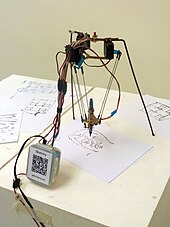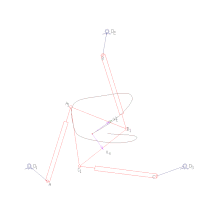Delta robot
This articleneeds additional citations forverification.(October 2009) |


Adelta robotis a type ofparallel robot[2]that consists of three arms connected touniversal jointsat the base. The key design feature is the use ofparallelogramsin the arms, which maintains the orientation of theend effector.[3]In contrast, aStewart platformcan change the orientation of its end effector.[3]
Delta robots have popular usage in picking and packaging in factories because they can be quite fast, some executing up to 300 picks per minute.[4]
History
[edit]
The delta robot (a parallel arm robot) was invented in the early 1980s by a research team led by professorReymond Clavelat theÉcole Polytechnique Fédérale de Lausanne(EPFL,Switzerland).[5]After a visit to achocolate maker,a team member wanted to develop a robot to placepralinesin their packages.[6]The purpose of this new type of robot was to manipulate light and small objects at a very high speed, an industrial need at that time.
In 1987, the Swiss company Demaurex purchased a license for the delta robot and started the production of delta robots for thepackaging industry.In 1991, Reymond Clavel presented his doctoral thesis 'Conception d'un robot parallèle rapide à 4 degrés de liberté',[7]and received the golden robot award in 1999 for his work and development of the delta robot. Also in 1999,ABB Flexible Automationstarted selling its delta robot, the FlexPicker. By the end of 1999, delta robots were also sold by Sigpack Systems.
In 2017, researchers fromHarvard's Microrobotics Labminiaturizedit withpiezoelectric actuatorsto 0.43 grams for 15 mm x 15 mm x 20 mm, capable of moving a 1.3 g payload around a 7 cubic millimeter workspace with a 5 micrometers precision, reaching 0.45 m/s speeds with 215 m/s² accelerations and repeating patterns at 75 Hz.[8]
Design
[edit]

The delta robot is aparallel robot,i.e. it consists of multiplekinematic chainsconnecting the base with the end-effector. The robot can also be seen as a spatial generalisation of afour-bar linkage.[9]
The key concept of the delta robot is the use of parallelograms which restrict the movement of the end platform to pure translation, i.e. only movement in the X, Y or Z direction with no rotation.
The robot's base is mounted above the workspace and all theactuatorsare located on it. From the base, three middle jointed arms extend. The ends of these arms are connected to a small triangular platform. Actuation of the input links will move the triangular platform along the X, Y or Z direction. Actuation can be done withlinearor rotational actuators, with or without reductions (direct drive).
Since the actuators are all located in the base, the arms can be made of a lightcomposite material.As a result of this, the moving parts of the delta robot have a smallinertia.This allows for very high speed and highaccelerations.Having all the arms connected together to the end-effector increases the robot stiffness, but reduces its working volume.
The version developed byReymond Clavelhas fourdegrees of freedom:[7]three translations and one rotation. In this case a fourth leg extends from the base to the middle of the triangular platform giving to the end effector a fourth, rotational degree of freedom around the vertical axis.
Currently other versions of the delta robot have been developed:
- Delta with 6 degrees of freedom: developed by theFanuccompany, in this robot a serial kinematic with 3 rotational degrees of freedom is placed on the end effector
- Delta with 4 degrees of freedom: developed by theAdeptcompany, this robot has 4 parallelogram directly connected to the end-platform instead of having a fourth leg coming in the middle of the end-effector
- Pocket Delta:developed by the Swiss companyAsyril SA,a 3-axis version of the delta robot adapted for flexible part feeding systems and other high-speed, high-precision applications.
- Delta direct drive: a 3 degrees of freedom delta robot having the motor directly connected to the arms. Accelerations can be very high, from 30[10]up to 100g.
- Delta cube: developed by theEPFLuniversity laboratory LSRO, a delta robot built in a monolithic design, having flexure-hinges joints. This robot is adapted for ultra-high-precision applications.
- Several "linear delta" arrangements have been developed where the motors drive linear actuators rather than rotating an arm. Such linear delta arrangements can have much larger working volumes than rotational delta arrangements.[11][12]
The majority of delta robots use rotary actuators. Vertical linear actuators have recently been used (using a linear delta design) to produce a novel design of3D printer.[13][14]These offer advantages over conventional leadscrew-based 3D printers of quicker access to a larger build volume for a comparable investment in hardware.
Applications
[edit]
Industries that take advantage of the high speed of delta robots are the food, pharmaceutical and electronics industry.[16][17]For its stiffness it is also used for surgery, in particular, theSurgiscopeis a delta robot used as a microscopic holder system.[18]
The structure of a delta robot can also be used to createhapticcontrollers.[19]More recently, the technology has been adapted to3D printers.[20]
References
[edit]- ^"Sketchy, a home-constructed drawing robot".Jarkman.
- ^Bonev, I. (2001) Delta Parallel Robot — the Story of Success, Online article available athttp:// parallemic.org/Reviews/Review002.html
- ^abBonev, I. The True Origins of Parallel Robots. Online article available athttp:// parallemic.org/Reviews/Review007.html
- ^"Robotics News & Articles".
- ^US 4976582,Clavel, Reymond, "Device for the movement and positioning of an element in space", published 1990-12-11, assigned to Sogeva SA
- ^Laure-Anne Pessina (7 March 2012)."Reymond Clavel, creator of the Delta Robot reflects on his career".EPFL. Archived fromthe originalon 27 October 2018.Retrieved19 January2018.
- ^abClavel, R. (1991)Conception d'un robot parallèle rapide à 4 degrés de liberté.PhD Thesis, EPFL, Lausanne, Switzerland
- ^Evan Ackerman (17 January 2018)."Harvard's milliDelta Robot Is Tiny and Scary Fast".IEEESpectrum.
- ^Merlet, J.-P., Parallel Robots, Kluwer Academic Publishers, 2000.
- ^Miller, K., "Modeling of Dynamics and Model-Based Control of DELTA Direct-Drive Parallel Robot," Journal of Robotics and Mechatronics, Vol. 17, No. 4, pp. 344-352, 1995.
- ^ "Gallery of robots - prof. Reymond Clavel"
- ^Reymond CLAVEL. "Robots parallèles"Archived20 September 2018 at theWayback Machine
- ^Johann Rocholl (6 February 2012)."Rostock (delta robot 3D printer)".Thingiverse.
- ^Mike Szczys (13 July 2012)."3D printing with a delta robot that seems to simplify the concept".
- ^"Hoosier Daddy – The Largest Delta 3D Printer in the World".3D Printer World.Punchbowl Media. 23 July 2014. Archived fromthe originalon 26 October 2014.Retrieved28 September2014.
- ^"Delta Parallel Robot - the Story of Success".parallemic.org.Retrieved30 December2023.
- ^"New Delta Robots Handle Primary Food Packaging".Packaging World.1 August 2022.Retrieved30 December2023.
- ^Deblaise, D.; Maurine, P. (2005).Effective geometrical calibration of a delta parallel robot used in neurosurgery.pp. 1313–1318.doi:10.1109/iros.2005.1545081.ISBN0-7803-8912-3.S2CID17649458.Retrieved30 December2023.
- ^Sunny Bains (8 August 2007)."Feeling virtual worlds".
- ^Carabin, G.; Scalera, L.; Wongratanaphisan, T.; Vidoni, R. (2021)."An energy-efficient approach for 3D printing with a Linear Delta Robot equipped with optimal springs".Robotics and Computer-Integrated Manufacturing.67:102045.doi:10.1016/j.rcim.2020.102045.S2CID224881163.
